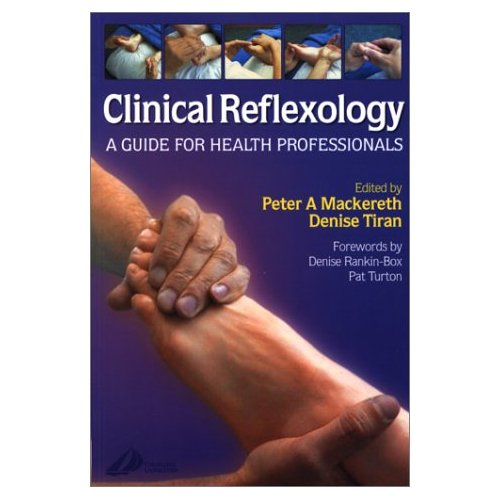
P A Mackereth, D Tiran, Clinical Reflexology A Guide for Health Professionals, 2nd Ed., 2003, Elsevier Science, ISBN 0-443-07120-9 --- PPPPP
Reference R1 Review

P A Mackereth, D Tiran, Clinical Reflexology A Guide for Health
Professionals, 2nd Ed., 2003, Elsevier Science, ISBN 0-443-07120-9 --- PPPPP
PRECIS OF CONTENTS:
There are 14 contributors to this book.
This book addresses a broad range of issues associated with reflexology and challenges assumptions providing an objective and research-based appraisal. Clinical techniques are introduced which provide evidence of the value of reflexology.
Supervision and support are explored and the reflective practice approach to therapy.
Key themes include; therapies and origins, preparatory and continuing education, challenging the rules, ethicolegal and professional principles, researching reflexology, clarifying healing and holism, the therapeutic relationship and safe effective practice.
Application of reflexology in specialist clinical areas include; integration in conventional healthcare settings, pregnancy and childbirth, the neonatal area, reflexology for those with learning disabilities, improving and maintaining mental health and enhancing quality. Innovative clinical techniques are introduced and key issues are overviewed. The book’s overall objective is to enhance the development of the reflexology profession. There is a strong focus on accountability, legal and ethical concerns and health and safety issues. Clinical practice is illustrated with case scenarios from the various contributors’ experiences.
VIEWS ON CONTENTS:
The Foreword starts, “This book is a timely and significant resource for anyone who is currently practising or considering using reflexology as a therapeutic tool.” I can add nothing to this statement!
It is a very well referenced, objective work by many contributors who have a genuine passion and belief in their subject, without fear of examination and a desire to see everything tested and assured.
Interesting techniques are presented such as ‘no hands reflexology’ which provides an alternative for therapists suffering with their hands or carpel tunnels. Such techniques provide all therapists with variations that could suit some clients more than the ‘standard’ techniques.
This book is a gem from an ex-applied physicist’s view. The sincerity of approach and desire to have a therapy that withstands the scrutiny and able to move forward in that way is not only admirable but the inevitable way to have reflexology truly taken on-board and used to the best advantage, ultimately of the recipient. The 2-way process protects and enhances the therapist, thus making for enthusiastic and energetic therapists able to provide so much. This book will no doubt be a great help to break down the barriers to integration into the healthcare environment.